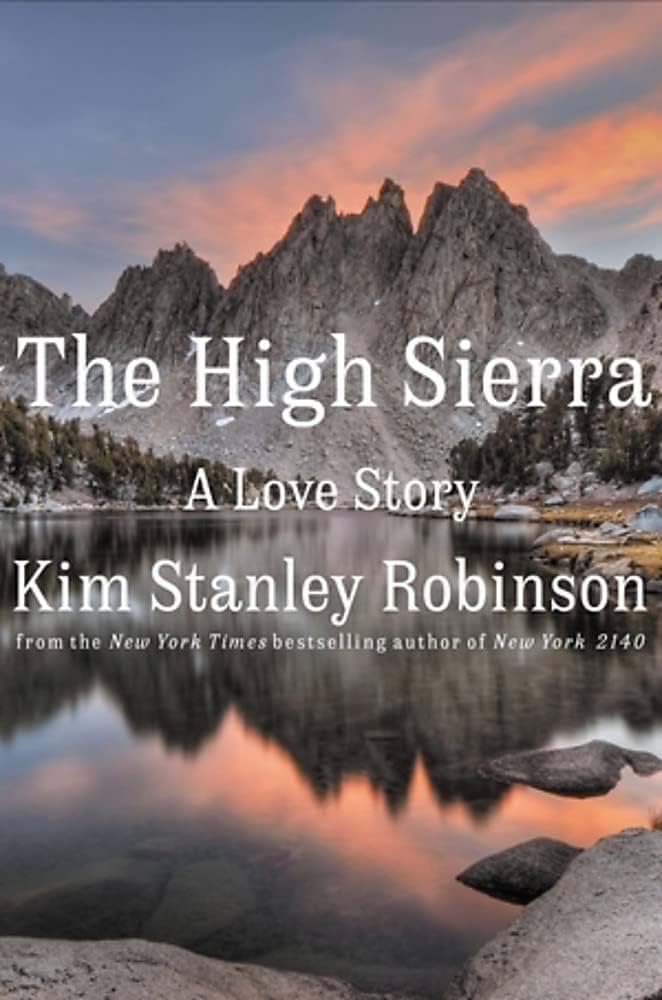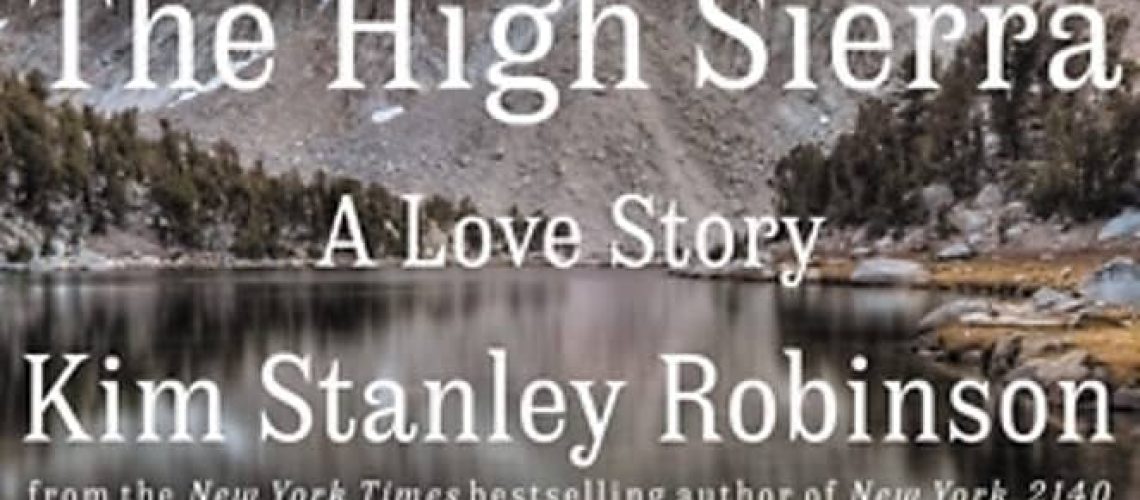Kim Stanley Robinson’s THE HIGH SIERRA: A LOVE STORY is a large and somewhat rambling depiction of the favorite place of SF writer Kim Stanley Robinson, through a variety of lenses.
Kim Stanley Robinson has a problem. He’s in love with not a beautiful highway, but rather a mountain range, what he considers the mountain range. For a man who has been to the Himalayas, the Alps, Antarctica and beyond, claiming that the Sierras are the mountain range is a bold claim. But how does one describe and present one’s relationship, and the sense of Place with the Sierra mountains? How does one convey this mountain range in all of its aspects, personal, historical, geographical, scientific, to the reader?
This is THE HIGH SIERRA: A LOVE STORY.

This doorstopper (>500 pages) thick square book is divided into several strands, whereupon he runs a chapter on a particular topic, and bounces between them. MY SIERRA LIFE details Stan’s personal adventures in the High Sierra (There is also a couple of chapters on THE SWISS ALPS which does the same for his time in Switzerland.). GEOLOGY goes into the physical bones of the Sierra, and acts as a really good introduction to mountain geology and understanding what one is seeing and experiencing. ROUTES talks about ways to traverse and explore the Sierra range. SIERRA PEOPLE discusses the historical people who have made the Sierra what it is, from familiar names like Muir to ones (and probably you, reader) have NOT heard of before. NAMES discusses place names in the Sierra, good ones, okay ones, and ones he is of the opinion should absolutely be changed. And MOMENTS OF BEING, where Robinson describes places, moments, events in the Sierra. He even has moments of poetry here in these sections. There are a couple of other strands of short length, too.
So the book is a lot and tries to do a lot of things all at once, which makes it a boat-car of a book sometimes. If you want a book just about one of these topics, you are going to be awfully frustrated, or flipping forward, fast. Readers of Robinson’s work can see elements of where the Sierra has influenced his own writing, especially for novels like SHAMAN. And his poetic side, something I really had not grokked, really comes through in some of the MOMENTS OF BEING. It’s a diverse book, though, so if you are tired of his latest trip to the Sierra, or had enough of geology, or enough of anything, the next chapter will switch it up almost without fail.
This makes the book pretty unique. I can’t think of many books by SF authors that are a love letter, basically to a place and what that place has meant to someone over the course of a lot of their life. I’ve read a lot of Robinson’s fiction, but this dive into nonfiction for him, and me, was illuminating to see him turn his storytelling efforts in this way. And, given his deep and abiding connection to the Sierras as he details it, it’s hard to imagine a book similar to this. Maybe Ada Palmer and Jo Walton could do a book on Florence in this manner, perhaps. Or Gillian Polack might explore Australia, similarly. But it would be a high wire act. There is real magic to be had in what Robinson has done. (Could this work be a Best Related Hugo nominee for me next year? Signs point to YES ).
I myself particularly enjoyed exploring the landscape with Robinson throughout this book. I am a very visual person, and a lover of landscapes, and so the descriptions of basins, fellfields, peaks and other features kept drawing me as a reader. And I kept thinking—how far is THAT in, could I do THAT safely as a day trip, and so forth. A lot of Robinson’s trips, all of them in fact, are multiday camping expeditions deep into basins. That might be a bit much for me coming into the state to do, but a day trip to see and photograph stuff—that is what I was interested in. But the places I will never get to see, the words of Robinson have suited me quite well to bring me to those places.
And in some ways, with the SIERRA LIFE chapters, this is the first stab at a biography of Robinson from his college years of 1973 to the present. He is frank and candid about his love of the Sierra and how that shaped him, his relationships, his friends. There is real bonding and camaraderie among him and his cadre up there in those mountains, and real pain when one of his good friends left him and his group to go his own way, forever. And the real tragedy of losing one of his longtime friends to illness. There are many heartfelt passages here for the reader. And the individual personalities of his friends, their likes, dislikes and approaches to the Sierra, are all distinct, well defined and they become your companions, your friends, for the time of reading this book.
I didn’t quite realize, but should have known, that Robinson was so adventurous. I knew he had been to the Himalayas and Antarctica, but his many adventures in the Sierra were eye-opening to him and to who and what he is. It’s clear that his love of these mountains has sculpted and shaped and changed him and helped make him into not only the writer, but also the person he is, today. If anyone does a full biography of him, MY SIERRA LIFE is going to be a good starting point on it.
As for the historical and personal sections of the book, I learned a lot. Readers who think the Sierras begin and end with Muir are in for an awakening and an education as to who had a big influence on this mountain range. Robinson does a conscious and good job at highlighting the roles of women in the Sierra as explorers, hikers and enthusiasts. He makes sure that their contribution to the story of the Sierras is not lost in an endless parade of white men exploring the range. It was surprising to me (but should not have been) just how adventurous some of those women explorers really were.
The issue I have with the book, though, is that it doesn’t have a good conclusion. After a chapter of a bibliography that one might expect as the end chapter, he just continues on with a few more chapters, until he comes to one talking about climate change buffeting the Sierra, from melting glaciers to monsoons hitting the mountains more frequently now. And then for the last chapter, he describes an amazing attempt at a pass and hike that is harrowing and funny and amazing. He has his friends and him in a harrowing adventure that goes very wrong (including broken fingers) but it is the most vivid chapter in a very vivid book.
And there the book stops. Ends. It is an extremely odd and strange place to end the book. It means that the book doesn’t really end and come to a conclusion so much as it just stops. I feel funny about this huge, giant book, with so much good material, as mentioned in this review, just coming to an end.
But the book can be considered a success in one additional respect. I’ve never seen the High Sierra, not even a day trip, much less the deep expeditions Robinson goes on and describes. But do I want to see and photograph some of it? You bet. Want to come along?








One Response
I did a couple of week-long camping trips into the Yosemite backcountry before I was 10, and the experiences stay with you! (They’re amazing mountains. Muir called it the Range of Light, and that’s one part of it. Seeing the east side, which is basically a wall of granite, is another.)